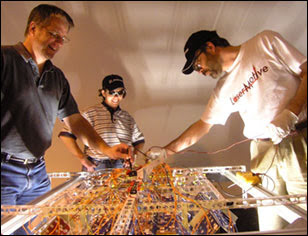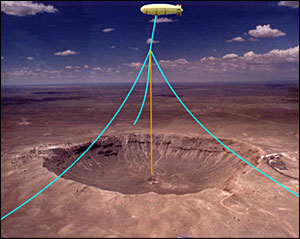
Trumpf to Aid Beam Teams
Trumpf Laser announced this week it will provide a TruDisk 8002 laser, along with on-site operation and support, for use by teams participating in the 2008 Space Elevator Beam Power Challenge.
The power-beaming competition is part of the Elevator:2010 Space Elevator Games, sponsored by the Spaceward Foundation, which concentrate on two far-reaching technology concepts that will enable NASA to enhance its space program: power beaming for wireless power transfer, and using nanonaterials such as carbon nanotubes for strong structures.
Teams entering the power-beaming challenge must power a vehicle more than 30 stories straight up a ribbon using only energy beamed to the vehicle from the ground. In the power-beaming competition, climbers must ascend a 100,000-km-long ribbon. 
LaserMotive, a Seattle-based team, works on a climber for the 2008 Space Elevator Beam Power Challenge. Left to right: Steve Beland; Boeing engineers Tamaira Ross and Brian Tillotson. (Photo copyright LaserMotive LLC)
Competing teams as well as Spaceward personnel will be available Thursday at the Trumpf exhibit (Booth 6130) at Photonics West, being held this week at the San Jose Convention Center in San Jose, Calif.
The goals of the 2008 challenge have been set at 1-km height, 5-m/s minimum speed, for a prize level of $2 million. An intermediate prize level of $900,000 will be given for a speed of 2 m/s, and teams that can reach an altitude of 1 km at between 1 and 2 m/s will be awarded a prize of up to $50,000. NASA has provided a total of $4 million in prize money to the games.
The tentative date for the 2008 competition is the week of Sept. 8; the location has not been determined. Team registration is open, and the latest revision of the competition handbook is available at www.spaceward.org/elevator2010-pb.html
Trumpf's TruDisk laser is a diode-pumped commercial laser source used for industry laser processes such as cutting and welding that enables the 1-km range. It uses a fiber optics-based beam distribution system that allows multiple teams to use the same beam source. For power-beaming applications, the beam is expanded over a large area so its intensity is reduced by several orders of magnitude. The beam is then directed at a photovoltaic panel similar to solar panels used on rooftops as a clean electrical energy source. The 1-km climb will be supported by a unique pyramid-anchored balloon system, providing teams with a stable tether.

Outline of the 2008 Space Elevator Beam Power Challenge superimposed on an image of the 1.2-km (3/4-mi) Meteor Crater in Arizona. (Image: Spaceward Foundation)
“Power beaming is about transferring power through light beams, and Trumpf’s know-how allows it to take a leading role in these games,” said Holger Schlueter, Trumpf vice president of laser technology. “Including myself, many of us here at Trumpf have never lost our excitement about space exploration, and my organization is thrilled to help shape the future of space travel."
The space elevator is a an earth-to-space transportation system proposed in 1960 by Yuri Artsutanov and enhanced in 2000 by Bradley C. Edwards, president and founder of Carbon Designs Inc., who was then with Los Alamos National Labs. The system is comprised of a stationary cable rotating in unison with the earth, with one end anchored to the surface of the planet and the other end in space. Electric cars then travel up and down the cable, carrying cargo and people.
Edwards said, "I'm looking forward to 2008 to be the year space elevator research and development really takes off. With recent results in the fields of carbon nanotubes and lasers, and with progress like we've been seeing in the Space Elevator challenge, we expect the perception that the space elevator is a near-term project to become more prevalent."
The Spaceward Foundation is a non-profit organization that advances space technology education. For more information, visit: www.spaceward.org
/Buyers_Guide/TRUMPF_Inc/c15237